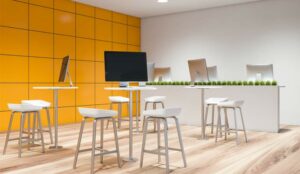Since hybrid work has come into the mainstream, many industry experts and thought leaders have been discussing how to best blend in-office and remote work in order to get the most productivity out of each space.
Major companies such as Apple are now mandating a Tuesday/Thursday in-office policy, which, in many cases, are explicitly expected to maximize the productivity of collaborative activities.
Alongside this, there has been a major rise in productivity-tracking software for white-collar jobs, which counts clicks and issues productivity points affecting reward metrics such as pay and bonuses. But these tools too often don’t account for brainstorming, small talk or other activities which are generally believed to contribute to innovation and culture within a company.
As recently as June, a BBC article even suggested that “in the hybrid-work world, head-down, focus tasks are for home, while the office is meant to be a centralized gathering place to combat the isolation of working on one’s own.”
While this was the general expectation at the start of the pandemic, we’re now seeing a much more nuanced debate about the value of workspaces begin to emerge.
As leaders continue to tweak and map out their workplace strategies, they need to be thinking about workspaces beyond the notion of where we are most productive. They must think about what makes employees feel they belong in any given space, as well as how to facilitate the wide range of needs of their employees in a hybrid work environment.
Increasing Your Employee Sense of Belonging Is Good for Business.
Why is it important to focus on belonging?
One 2019 study from BetterUp published in Harvard Business Review showed that employees with high belonging showed a 56% increase in job performance and a 50% decrease in turnover risk.
With bottom-line impacts like this, as well as increasing pressure from employees to give them more choice in how they structure their workweek, it’s becoming clear that belonging will be the next great workplace experience metric. So, how does belonging relate to how we design physical workspaces?
Different People Report Different Reasons for Coming Into the Office.
My team’s recent Hybrid Ways of Working 2022 Global Report at Jabra asked 2,800 knowledge workers around the globe to rank their main reasons for wanting to come back into the office. Here were the top three responses:
- Having focus time (90%)
- Collaborating in person (89%)
- Socializing with colleagues (88%)
As we can see from this data, there’s no single purpose that the physical office space serves; every employee has different reasons for wanting to come into the office. As such, whether they feel they belong there will depend entirely upon whether they feel that their employer has designed that space for them or provided them with the tools to make it their own.
Desire for Personalized Workspaces Requires a Rethinking of Hot Desking.
One of the main ways that companies are responding to a reduced headcount in the office is by implementing a hot desking arrangement in which there’s no assigned seating and employees sit wherever there’s available space.
However, our new data also shows that this can spell trouble for companies not because of a drop in productivity, but because of a decrease in employee loyalty. In fact, nearly 4 in 10 employees say they would feel less loyalty and commitment to their company if they didn’t have a regular, permanent workspace in the office.
Clearly, hot desking is a logical decision to optimize space usage, and I myself would otherwise advocate such a strategy. But this decision does not occur in a vacuum. Outside studies also show that as dedicated, personal in-office spaces decline, the regularity with which we are meeting in virtual spaces is on the rise. In fact, 68% of IT workers and 52% of non-IT workers report they are attending more virtual meetings now than they were before the pandemic.
Because of this, leaders will be required to think differently about what “belonging” means. We’ll need to be just as conscious of what it means to belong in virtual environments as we are in physical ones.
Professional Meeting Technology Boosts Belonging in the Virtual Era
With this many meetings happening virtually, the way we access those meetings will clearly impact the experience. The technology we use can be the defining factor in whether we feel we belong in the virtual space. And similarly, the flexibility of that technology—that is, our ability to use it across many different workspaces—will determine whether we consider a space to be a viable workspace.
Our report showed that employees using professional audio devices are 12%-14% more likely to hear what’s being said in virtual meetings than those who don’t. Obviously, if we can’t even hear what’s being said, it’s very unlikely that we’ll feel included in the conversation and even less likely that we’ll leave that conversation with an increased sense of belonging.
The same goes with video: 70% of employees say standardized professional video cameras would help everyone participate equally in hybrid meetings. When everyone can hear and be heard, as well as see and be seen from wherever they’re working, it’s far easier to feel that you belong in the space in which you’re working.
Take the Time to Ensure Your Online Meetings Are up to Date.
While productivity is a valuable concern and one important factor for which business leaders must account, they must avoid tunnel vision on assigning certain tasks to certain locations. Instead, they need to turn their attention to belonging and explore how professional meeting technology boosts our ability to belong everywhere, from anywhere.
Author: Guest Author
Published On: 7th Nov 2022 - Last modified: 6th Jun 2023
Read more about - Guest Blogs, Jabra
















